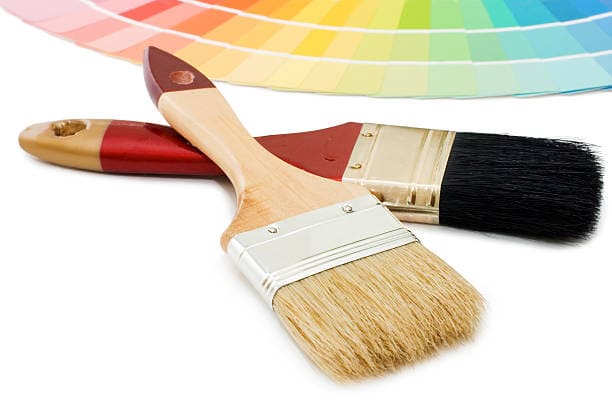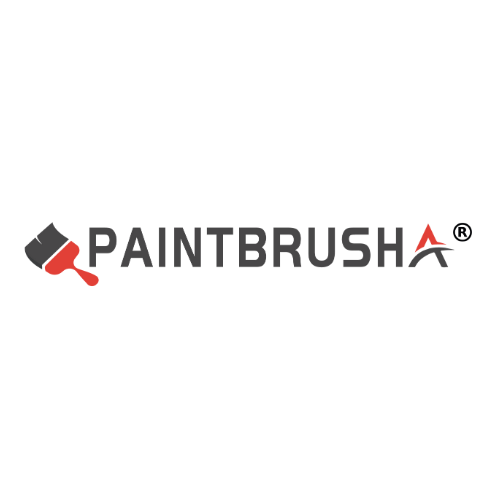The paintbrush is one of the most used tools in the home. It’s very versatile and can be used for many different projects. Paint brushes come in various sizes, shapes and materials: In this article, we will explore the different types of Paint Brushes, their consideration before buying, maintenance tips and uses, etc.

How to Choose The Right Paintbrush & Parts of A Paintbrush
There are a dizzying variety of brushes, each designed to work best with specific types of paint and finishes and for specific projects. Recognizing which brush is suitable for which job can be confusing. Here’s what you need to know about paintbrushes to make the right choice.
When it comes to brushes, you have a lot of options. You can get natural bristles or synthetic fibres for all paints, or you can go with flat, square, round or angled bristles. Most brushes will come in sizes ranging from 1/2 in. to 6-in. 20mm to 10mm. 30x70mm to 50x150mm.

Most brushes will have wooden handles, plastic handles or rubber plastic handles; if you choose wood and plastic, consider which one feels more comfortable in your hand and easier to hold onto during painting sessions.
The ferrule is usually made of tin, aluminium, brass, copper or stainless steel.
The paintbrush is one of the essential tools for any painter. It’s a necessary tool and can be used for many different things. The paintbrush is made up of several different components that make it work properly. The bristles hold the paint, while the handle allows you to apply it.
Paintbrush Buying Tips
If you’ve never used a paintbrush before, you may wonder how to use it. And if you want to give your house a fresh look, this is one of the essential tools you can use.
When it comes to picking out a paintbrush, there are two things to consider:
1. Is the brush flagged (split ends)?
If so, it will hold paint better than a brush without split ends.
A flagged bristle is a type of paintbrush made from very coarse fibres. It is also called a “heavy duty” brush because it is ideal for covering large areas, such as walls and ceilings, with heavy-duty paints.
Flagged bristles are best used when applying paint quickly and evenly across large surfaces with minimal effort. This brush can be used in corners or edges where other types may not work well due to its ability to spread out evenly without breaking up the surface underneath it (this can happen with regular brushes).
2. How expensive is the brush?
A quality brush will last longer and only need replacing as often as cheaper brushes.
Different Types of Paint Brushes
Flat Wall Brush
Flat wall brushes are used for painting the interior walls. They are made of natural or synthetic bristles and have flat, rectangular heads. These brushes are ideal for painting drywall, plastering and other surfaces that require a smooth finish.

Angled Brush
The angled brush is used for painting corners, baseboards and ceiling edges. It can also be used to paint around moulding and other areas where you may have difficulty reaching the wall. This type of brush is suitable for large areas because it has a broader head than its counterpart, making it easier to control your painting strokes and more effective at covering up walls that could be perfectly smooth.

The angled brush will allow you to do different things than a flat or round brush would do: For example, if there’s a gap between two pieces of drywall (or plaster), this type can fill in those spaces by tilting them slightly away from each other before applying paint on top!
Round Trim Brush
The round trim brush is used for painting corners and edges. It has a small flat area at the top of its head, making it easier to get into small spaces. This paintbrush also comes in various sizes, so you can choose which size works best for your project.
The round trim brush is ideal for painting ceilings because it will not leave any streaks on them when appropriately applied.
Trim brushes have very short handles that allow the person using them complete control over the brush. This increase in control also means that the person using the brush will not get as quickly tired when using it and can work much faster. The smaller size of these brushes increases the user’s control, making it much easier to manoeuvre them in smaller spaces. They can be used anywhere that you want to use an angled sash brush, but due to the smaller size and the way that the handle is designed, you are likely to have much better control and will be able to complete the job a lot faster when you use a trim brush.

Finishing Brush
Finishing brushes are used for detailed work, such as painting trim and moulding. They have a short, stiff bristle length and are usually made from hog hair. The bristles are usually made from hog hair, which is stiff and has strong colour retention.
Finishing brushes tend to be more expensive than other paintbrushes because they’re more delicate in use—you’ll want to ensure you’re getting your money’s worth when buying one!
Stencil Brush
Stencil brushes are used to apply paint to stencils. They have a small, flat head and a fine, soft bristle. Because they’re so tiny in size, stencil brushes can be used for precise work on small areas like lettering or logos—and because their bristles are so soft and flexible, you won’t need to worry about damaging delicate surfaces with your brush strokes.
Stencil Brushes come in different sizes:
0-3/4″ – This size is perfect for painting intricate designs on canvas or paper (think paintings).
3-1/2″ – This more extensive version of the regular 0-3/4″ brush will make quick work of large surfaces such as murals or panelling walls before applying multiple layers of colour at once!
Foam Brush
Foam paint brushes are soft and absorbent, making them ideal for applying paint to large areas. They’re also great for applying paint to delicate surfaces like glass or metal. The bristles on foam paint brushes have a round shape that allows them to glide smoothly across the surface of whatever you’re painting, while their density makes it easy to control how much liquid dries before hitting your project again.

Long Reach Brush
Long-reach brushes are used for painting ceilings, walls and other high places. They come in different sizes, but the most common is the 1-inch extended version. This brush has a good grip and allows you to paint smoothly on your ceiling without bending over too much.

Long-reach brushes are made of nylon or polyester fibres that help them hold their shape after repeated use despite being hard-bristle brushes made from natural materials such as wood or resin (as opposed to synthetics).
Artist Brush
Artist brushes are made from hog hair. Hog hair is the most common type of natural hair used in making paint brushes, as it’s soft enough to be manipulated by delicate touches but also strong enough for large strokes. Use an artist’s brush to add detail or accentuate your work with watercolour or oil paints.

You can use this brush for everything from quick sketches to finished paintings!
Round Sash
Round Sash is used for painting corners and trim. It has a flat end, which makes it easy to paint straight lines with it. The round handle allows you to hold the brush in any position while painting and gives you more control over your movement. This brush can also be used on ceilings but not much else since it doesn’t have any large surface area like those other types.
The size of your paintbrush will depend on what you’re painting and the size of the surface. An angled brush would be best if you’re painting a large surface since it covers more area with each stroke. If you’re doing fine work or using a small surface, then a smaller brush would be better for control over your movements.
The brush should be soft enough to allow the bristles to bend slightly when applying pressure. This will give you more control over your movements and prevent any streaks that may appear on the surface of your painting.
Different Types of Bristles
There are three main types of bristles in paint brushes: hog bristle, mixture bristles, and synthetic fibres. Hog bristle is the most common type of brush today and has been used since ancient times. It comes from the coat of a boar (or hog) and can be found in different colours, including white and black. Mixture bristles are also very versatile; it is mixed with different percentage of bristles and synthetic fibres. Synthetic fibres are made from polymers such as polypropylene or polyethene terephthalate (PET).

Bristles are made of animal hair and can be thick or thin, long or short. They have a natural bend and give your work a more organic feel. Nylon: Nylon brushes are made of smooth plastic on both sides, so they don’t leave marks on your surface when you’re painting with them (if you don’t want any!). These brushes are cheaper than bristle ones but last longer because they don’t fray as easily after years of use! Foam: Foam brushes are great because they offer both high-quality performance at an affordable price point; however, some people prefer having a mix between these two types since there aren’t many options out there right now (although I’m sure we’ll see more soon).
Paintbrushes are an essential tool in house painting. They help you apply the paint evenly and get into those hard-to-reach places. Paint brushes come in different sizes, shapes, materials and prices, so there is something for everyone!

Some people prefer to use a brush with long bristles, while others prefer shorter ones. If you are painting a large area, it is best to use longer brushes as they can cover more surface area in less time than a short one.

The bristles on foam paint brushes are usually made from nylon, a potent synthetic material that won’t absorb water. As such, they’re great for applying high-quality finishes like varnish or shellac to wood surfaces. Make sure they are labelled as synthetic or natural when buying paintbrushes. Natural bristles tend to be softer than synthetic ones but break more easily.
Paint Brush Uses
Paint brushes are used for painting projects but can also be used for other applications. Some examples of other uses for paintbrushes include:
Cleaning windows or mirrors
Polishing wood floors or furniture
Washing dishes
and so on
Painting is a prevalent task that people do around their houses. It can be used for many different things, including cleaning and polishing.
The paintbrush is one of the essential tools for any painter. It’s a necessary tool and can be used for many different things.
The best thing about these brushes is that they are durable and withstand frequent use. They are also straightforward to clean, so you don’t have to spend much time cleaning them after each use.
Care Should be Taken for Paint Brush
There are a few things you should keep in mind when it comes to cleaning paintbrushes.
Always wash the brush in warm water and use soap or dishwashing liquid instead of detergent. If you want to clean your brushes, make sure they are scorched before storing them away again.
Avoid using bleach as it can damage the bristles, causing them to become brittle and break off easily when used repeatedly over time. Do not use hot water, as this will also damage the bristles, causing them to become brittle and break off easily when used repeatedly over time.
Like well, or spring water, water with high mineral content can leave a white residue on the bristles. This is because of the minerals in the water, which are left behind when it dries off. You should only use tap water for cleaning paint brushes as this will ensure they do not become damaged over time.
When storing your brushes, ensure they are scorched before doing so. Avoid using bleach as it can damage the bristles, causing them to become brittle and break off easily when used repeatedly over time. Do not use hot water, as this will also damage the bristles, causing them to become brittle and break off easily when used repeatedly over time. Like well, or spring water, water with high mineral content can leave a white residue on the bristles.
Why Choose Paintbrusha
Paintbrusha is a company that has been in the painting tool industry for 35 years, focusing on paint brushes & paint rollers, and we’re proud of our reputation. We always provide our customers with the best service possible.

Our team of experts has provided quality paint brushes and rollers for overseas and domestic customers for years, ensuring that we are well-versed in the needs of each customer.
Our company is committed to creating a high-quality product at competitive prices. If you are interested in finding out more about our products or services, drop us a message. We are the right choice for your next painting project!
Happy Painting
In this article, we’ve covered the different types of paintbrushes and how to use them. We discussed which type is best for your project and what kind of bristles would suit it. We also discussed properly cleaning your brush after using it with different paints.
I hope this article helps you. Happy Painting!

